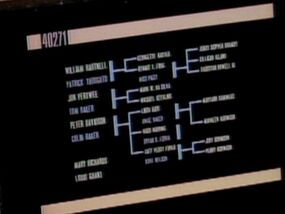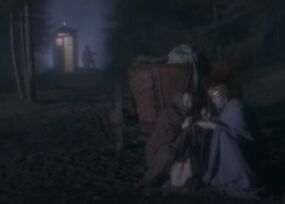Cultural references to the Doctor Who universe/1980s: Difference between revisions
No edit summary Tag: 2017 source edit |
|||
| Line 30: | Line 30: | ||
=== Television === | === Television === | ||
* [[File:Star Trek Doctor Who.jpg|thumb|"[[William Hartnell (Pier Pressure)|William Hartnell]]", "[[Patrick Troughton (Bafflement and Devotion)|Patrick Troughton]]", "[[Jon Pertwee (Ever Wondered What Happened At.. The Auditions For The Seven Doctors?)|Jon Pertwee]]", "[[Tom Baker (Bafflement and Devotion)|Tom Baker]]", "[[Peter Davison (N-Space)|Peter Davidson]]", and "[[Colin Baker (Peter Capaldi and Simon the Shy Cyberman Invite You to Breakfast with 7 Doctors)|Colin Baker]]" appear on a computer display. (''[[w:c:memory-alpha:The Neutral Zone|The Neutral Zone]]'')]]In the {{wi|Star Trek: The Next Generation}} episode "{{iw|startrek|The Neutral Zone}}" (1988), the names of the first six Doctor actors ([[William Hartnell]], [[Patrick Troughton]], [[Jon Pertwee]], [[Tom Baker]], [[Peter Davison]], and [[Colin Baker]]) are seen on a screen. (Due to a mistake, Davison's name is misspelled as "Davidson".) These names were replaced in the remastered Blu-ray version. | * [[File:Star Trek Doctor Who.jpg|thumb|"[[William Hartnell (Pier Pressure)|William Hartnell]]", "[[Patrick Troughton (Bafflement and Devotion)|Patrick Troughton]]", "[[Jon Pertwee (Ever Wondered What Happened At.. The Auditions For The Seven Doctors?)|Jon Pertwee]]", "[[Tom Baker (Bafflement and Devotion)|Tom Baker]]", "[[Peter Davison (N-Space)|Peter Davidson]]", and "[[Colin Baker (Peter Capaldi and Simon the Shy Cyberman Invite You to Breakfast with 7 Doctors)|Colin Baker]]" appear on a computer display. (''[[w:c:memory-alpha:The Neutral Zone|The Neutral Zone]]'')]]In the {{wi|Star Trek: The Next Generation}} episode "{{iw|startrek|The Neutral Zone}}" (1988), the names of the first six Doctor actors ([[William Hartnell]], [[Patrick Troughton]], [[Jon Pertwee]], [[Tom Baker]], [[Peter Davison]], and [[Colin Baker]]) are seen on a screen. (Due to a mistake, Davison's name is misspelled as "Davidson".) These names were replaced in the remastered Blu-ray version. | ||
* The video for Billy Bragg’s song ‘’Greetings to the New Brunette’’ features, amongst other archive footage, two shots seemingly taken from a home movie. These show a home-made [[Dalek]] costume “fighting” with a more generic silver robot. The song came out in 1986. | |||
[[Category:Cultural references to the Doctor Who universe by decade]] | [[Category:Cultural references to the Doctor Who universe by decade]] | ||
Revision as of 21:25, 29 December 2022
Occasionally, elements of the Doctor Who universe are referenced in the broader popular culture. This page exists to throw a spotlight on some of these casual references made in television, comics, films and other media which happened during the 1980s.
In-universe references
These references functionally act as minor, unlicensed crossovers between the series and the DWU: some element of the Doctor Who universe makes a cameo, or is referenced, in such a way as to imply that it is real in the world of the story, or indeed that the story itself "unofficially" takes place in the Doctor Who universe.
Television
- "Arrivederci Roma", the first episode of Channel 4's comedy programme Chelmsford 123, showed the TARDIS materialising in the background in one scene. The Doctor briefly stepped out before going back in and dematerialising.
Films
- In the 1985 Lego stop-motion animation (brick film as dubbed by Lego enthusiasts), The Magic Portal has three Lego minifigures who find themselves outside of their Lego universe and in the human world, via the use of the mysterious titular "Magic Portal". They are then subsequently attacked by a squad of "Daleks" (who are in fact made from a combination of a tippex bottles and screws).
Comics
Marvel UK
- The Doctor Who comics version of Merlin the Wise appeared briefly in The Daredevils Vol 1 1 (1983) in a sequence demonstrating that Merlin had several alternate appearances and personalities that he could adopt as he saw fit.
- The characters of the Special Executive (troubleshooters employed by the Time Lords, who had appeared in 4-D War and Black Sun Rising) appeared with Captain Britain in The Daredevils Vol 1 5-11 (1983) written by the Special Executive's creator, Alan Moore.
- In Uncanny X-Men Vol 1 218 (1987), Brigadier Lethbridge-Stewart and Sergeant-Major Benton appear with the British Army.
- Professor Alistaire Stuart and Brigadier Alysande Stuart of the Weird Happenings Organisation (W.H.O., a nod to UNIT and Doctor Who) are introduced in Excalibur Vol 1 6 (1989). Alistaire Stuart mentions meeting someone from Gallifrey in Excalibur Vol 1 25 (1990).
- A Dalek appears in Excalibur Vol 1 14 (1989).
Prose
- Barbara Hambly's Star Trek novel Ishmael (1985) contains references to Doctor Who and cameo appearances by the Second Doctor, the Fourth Doctor and Leela.
- The Red Dwarf novels have a number of references. Kryten, for example, owns a sonic screwdriver in Infinity Welcomes Careful Drivers (1989).
- The 1985 Advanced Dungeons & Dragons adventure module "The City Beyond the Gate", set in present-day London, features a random encounter table which includes the text: "A tall, blue box with a bright light on top is found. A tall, curly-haired man with a floppy hat and long scarf enters the box, followed by a girl saying, 'But Doctor, where are we going now?' The light starts to blink, and the box makes hideous screeching noises and slowly vanishes. This encounter can only occur once."
Out-of-universe references
These references are to Doctor Who (or one of its spin-offs) as works of fiction. They merely establish that fiction about the Doctor or the Daleks exists in the fictional universe of the story, as it does in the real world.
Television
- In the Star Trek: The Next Generation episode "The Neutral Zone" (1988), the names of the first six Doctor actors (William Hartnell, Patrick Troughton, Jon Pertwee, Tom Baker, Peter Davison, and Colin Baker) are seen on a screen. (Due to a mistake, Davison's name is misspelled as "Davidson".) These names were replaced in the remastered Blu-ray version.
 "William Hartnell", "Patrick Troughton", "Jon Pertwee", "Tom Baker", "Peter Davidson", and "Colin Baker" appear on a computer display. (The Neutral Zone)
"William Hartnell", "Patrick Troughton", "Jon Pertwee", "Tom Baker", "Peter Davidson", and "Colin Baker" appear on a computer display. (The Neutral Zone) - The video for Billy Bragg’s song ‘’Greetings to the New Brunette’’ features, amongst other archive footage, two shots seemingly taken from a home movie. These show a home-made Dalek costume “fighting” with a more generic silver robot. The song came out in 1986.

